Racism and Trauma Among Refugees: A Case Study of Amina
VerifiedAdded on 2022/12/14
|8
|2493
|56
AI Summary
This report examines the impact of racism and trauma on refugees, using a case study of Amina. It explores the different forms of racism, such as institutional, social, and individual racism, and how they affect refugees. The report also discusses the issues that specifically affect refugees and the implications for trauma-informed care. Recommendations are provided for policies and practices to support refugees.
Contribute Materials
Your contribution can guide someone’s learning journey. Share your
documents today.
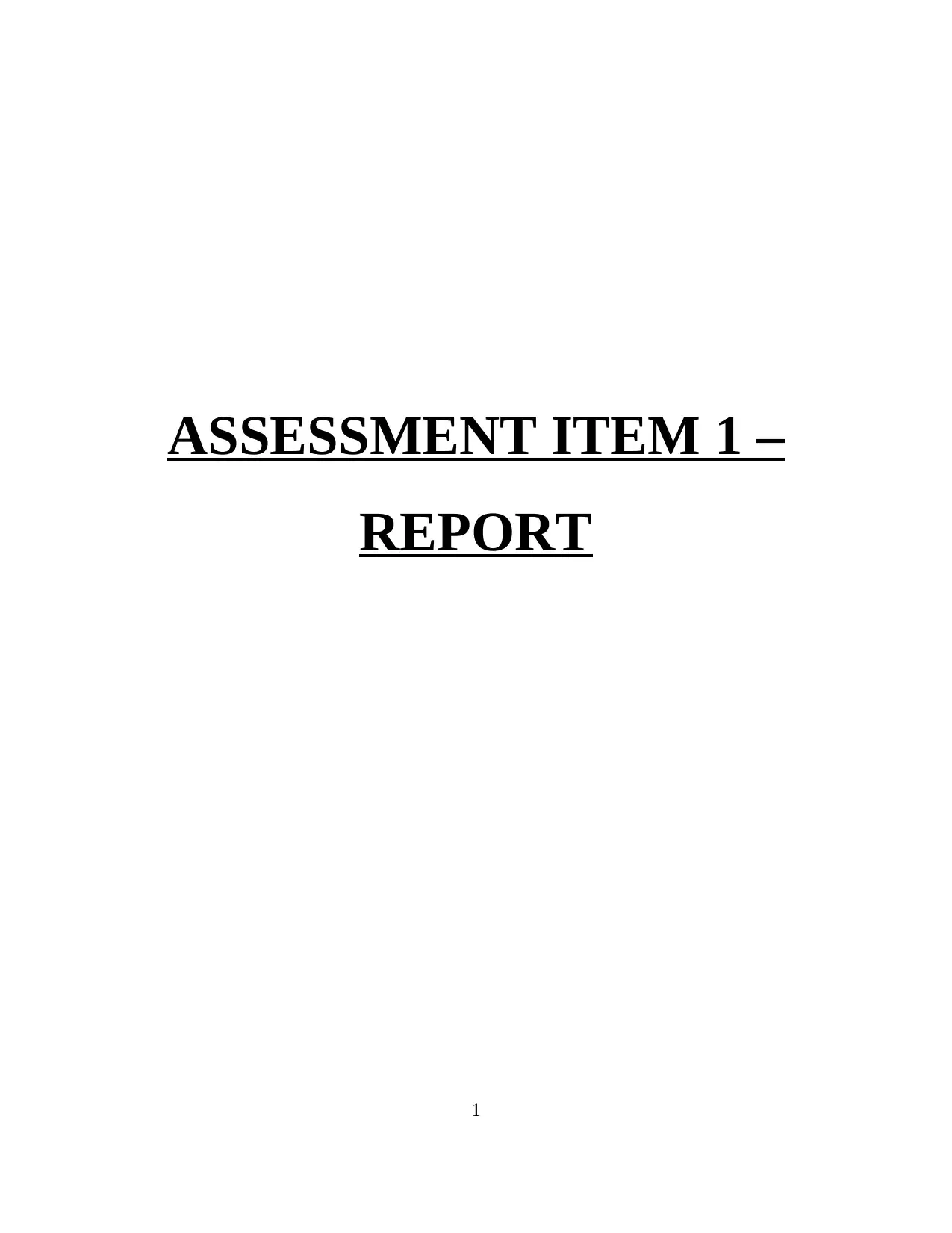
ASSESSMENT ITEM 1 –
REPORT
1
REPORT
1
Secure Best Marks with AI Grader
Need help grading? Try our AI Grader for instant feedback on your assignments.
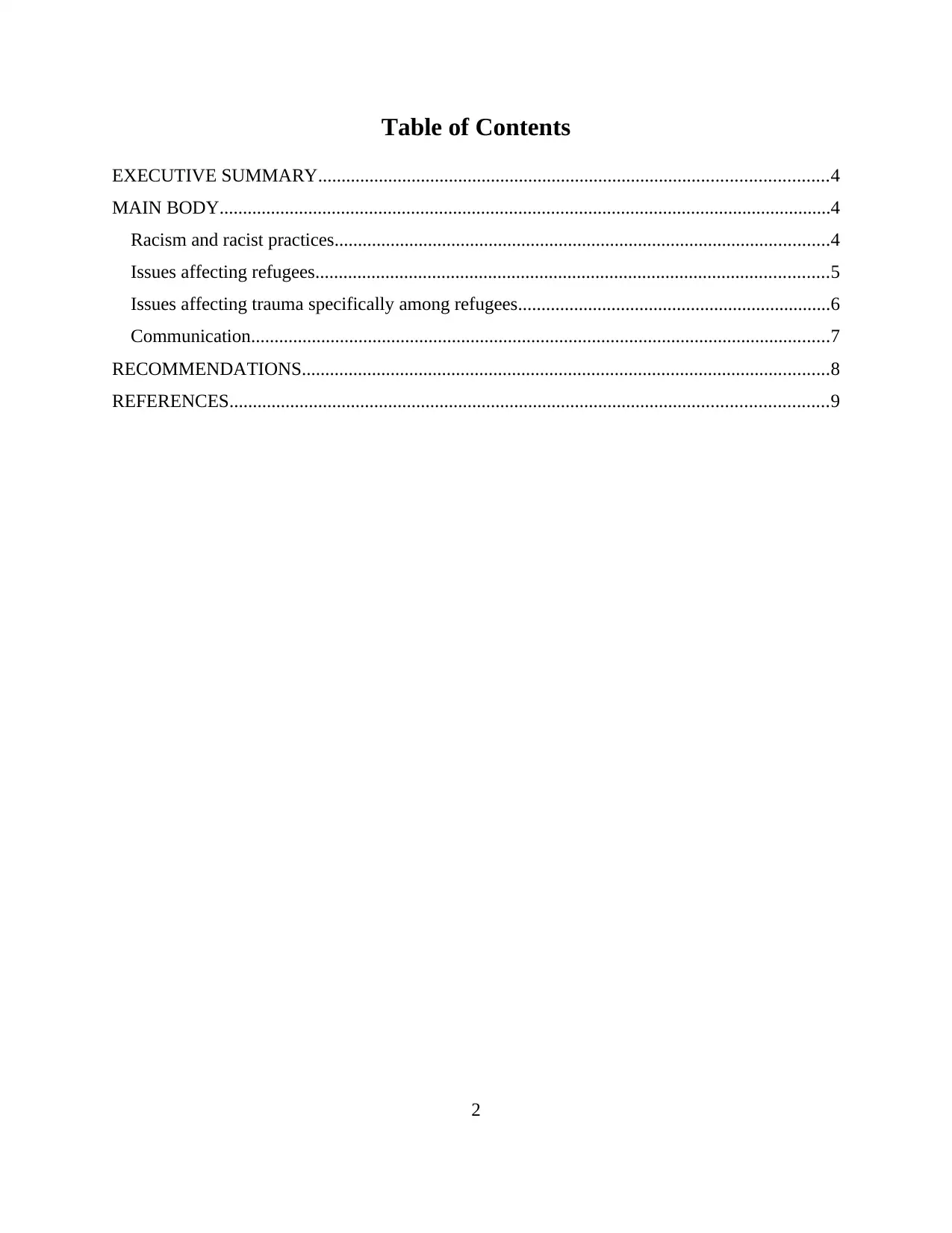
Table of Contents
EXECUTIVE SUMMARY.............................................................................................................4
MAIN BODY...................................................................................................................................4
Racism and racist practices..........................................................................................................4
Issues affecting refugees..............................................................................................................5
Issues affecting trauma specifically among refugees...................................................................6
Communication............................................................................................................................7
RECOMMENDATIONS.................................................................................................................8
REFERENCES................................................................................................................................9
2
EXECUTIVE SUMMARY.............................................................................................................4
MAIN BODY...................................................................................................................................4
Racism and racist practices..........................................................................................................4
Issues affecting refugees..............................................................................................................5
Issues affecting trauma specifically among refugees...................................................................6
Communication............................................................................................................................7
RECOMMENDATIONS.................................................................................................................8
REFERENCES................................................................................................................................9
2
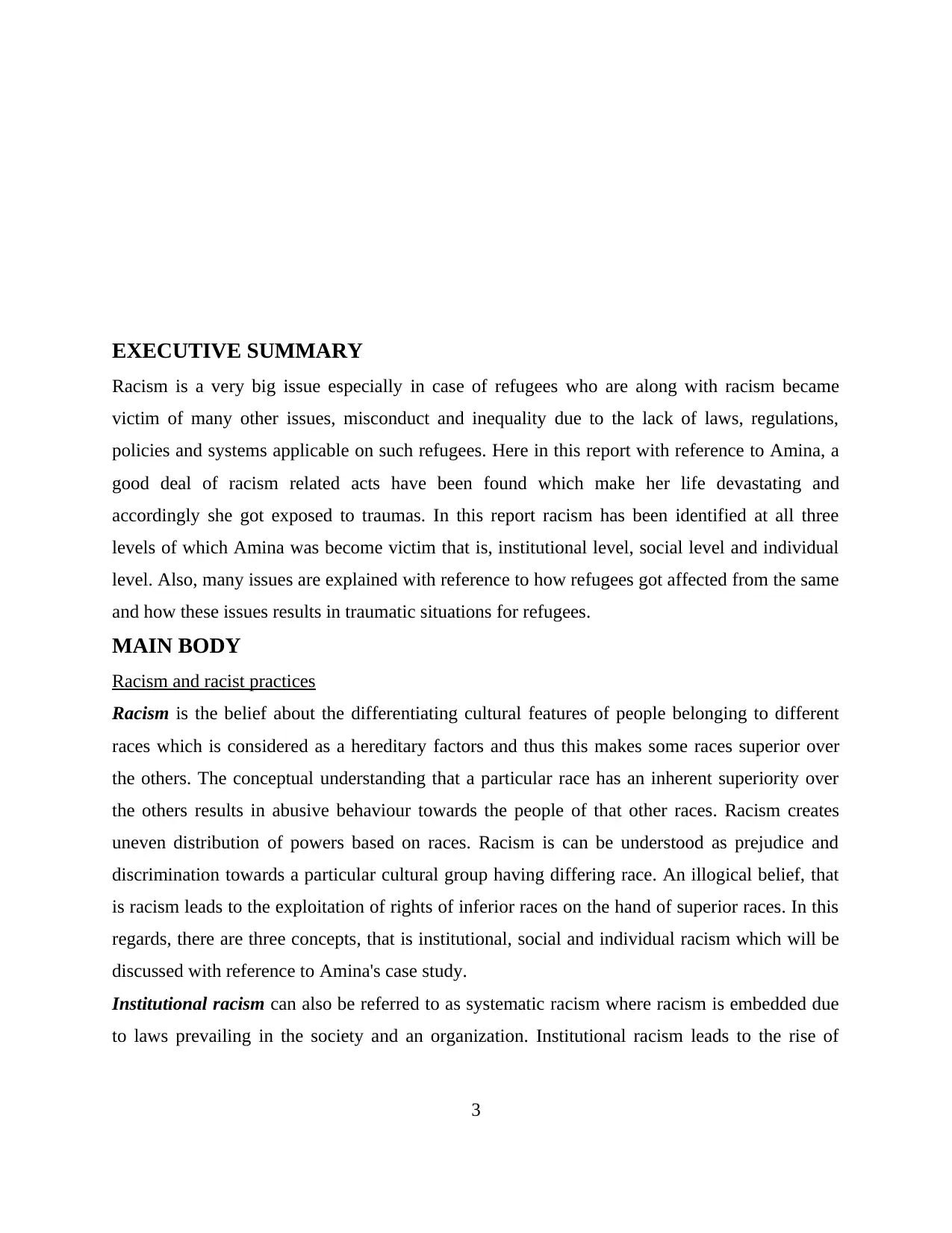
EXECUTIVE SUMMARY
Racism is a very big issue especially in case of refugees who are along with racism became
victim of many other issues, misconduct and inequality due to the lack of laws, regulations,
policies and systems applicable on such refugees. Here in this report with reference to Amina, a
good deal of racism related acts have been found which make her life devastating and
accordingly she got exposed to traumas. In this report racism has been identified at all three
levels of which Amina was become victim that is, institutional level, social level and individual
level. Also, many issues are explained with reference to how refugees got affected from the same
and how these issues results in traumatic situations for refugees.
MAIN BODY
Racism and racist practices
Racism is the belief about the differentiating cultural features of people belonging to different
races which is considered as a hereditary factors and thus this makes some races superior over
the others. The conceptual understanding that a particular race has an inherent superiority over
the others results in abusive behaviour towards the people of that other races. Racism creates
uneven distribution of powers based on races. Racism is can be understood as prejudice and
discrimination towards a particular cultural group having differing race. An illogical belief, that
is racism leads to the exploitation of rights of inferior races on the hand of superior races. In this
regards, there are three concepts, that is institutional, social and individual racism which will be
discussed with reference to Amina's case study.
Institutional racism can also be referred to as systematic racism where racism is embedded due
to laws prevailing in the society and an organization. Institutional racism leads to the rise of
3
Racism is a very big issue especially in case of refugees who are along with racism became
victim of many other issues, misconduct and inequality due to the lack of laws, regulations,
policies and systems applicable on such refugees. Here in this report with reference to Amina, a
good deal of racism related acts have been found which make her life devastating and
accordingly she got exposed to traumas. In this report racism has been identified at all three
levels of which Amina was become victim that is, institutional level, social level and individual
level. Also, many issues are explained with reference to how refugees got affected from the same
and how these issues results in traumatic situations for refugees.
MAIN BODY
Racism and racist practices
Racism is the belief about the differentiating cultural features of people belonging to different
races which is considered as a hereditary factors and thus this makes some races superior over
the others. The conceptual understanding that a particular race has an inherent superiority over
the others results in abusive behaviour towards the people of that other races. Racism creates
uneven distribution of powers based on races. Racism is can be understood as prejudice and
discrimination towards a particular cultural group having differing race. An illogical belief, that
is racism leads to the exploitation of rights of inferior races on the hand of superior races. In this
regards, there are three concepts, that is institutional, social and individual racism which will be
discussed with reference to Amina's case study.
Institutional racism can also be referred to as systematic racism where racism is embedded due
to laws prevailing in the society and an organization. Institutional racism leads to the rise of
3
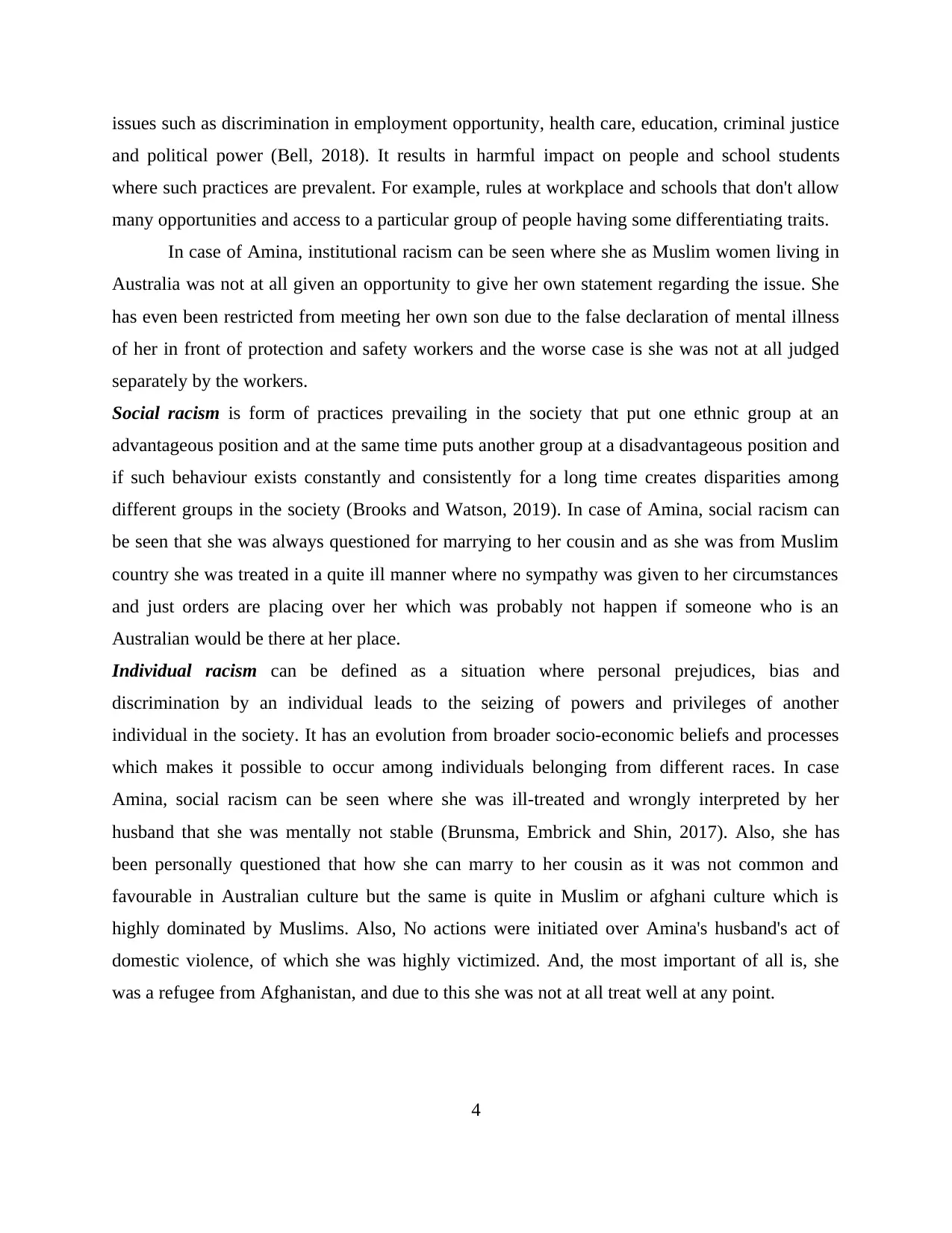
issues such as discrimination in employment opportunity, health care, education, criminal justice
and political power (Bell, 2018). It results in harmful impact on people and school students
where such practices are prevalent. For example, rules at workplace and schools that don't allow
many opportunities and access to a particular group of people having some differentiating traits.
In case of Amina, institutional racism can be seen where she as Muslim women living in
Australia was not at all given an opportunity to give her own statement regarding the issue. She
has even been restricted from meeting her own son due to the false declaration of mental illness
of her in front of protection and safety workers and the worse case is she was not at all judged
separately by the workers.
Social racism is form of practices prevailing in the society that put one ethnic group at an
advantageous position and at the same time puts another group at a disadvantageous position and
if such behaviour exists constantly and consistently for a long time creates disparities among
different groups in the society (Brooks and Watson, 2019). In case of Amina, social racism can
be seen that she was always questioned for marrying to her cousin and as she was from Muslim
country she was treated in a quite ill manner where no sympathy was given to her circumstances
and just orders are placing over her which was probably not happen if someone who is an
Australian would be there at her place.
Individual racism can be defined as a situation where personal prejudices, bias and
discrimination by an individual leads to the seizing of powers and privileges of another
individual in the society. It has an evolution from broader socio-economic beliefs and processes
which makes it possible to occur among individuals belonging from different races. In case
Amina, social racism can be seen where she was ill-treated and wrongly interpreted by her
husband that she was mentally not stable (Brunsma, Embrick and Shin, 2017). Also, she has
been personally questioned that how she can marry to her cousin as it was not common and
favourable in Australian culture but the same is quite in Muslim or afghani culture which is
highly dominated by Muslims. Also, No actions were initiated over Amina's husband's act of
domestic violence, of which she was highly victimized. And, the most important of all is, she
was a refugee from Afghanistan, and due to this she was not at all treat well at any point.
4
and political power (Bell, 2018). It results in harmful impact on people and school students
where such practices are prevalent. For example, rules at workplace and schools that don't allow
many opportunities and access to a particular group of people having some differentiating traits.
In case of Amina, institutional racism can be seen where she as Muslim women living in
Australia was not at all given an opportunity to give her own statement regarding the issue. She
has even been restricted from meeting her own son due to the false declaration of mental illness
of her in front of protection and safety workers and the worse case is she was not at all judged
separately by the workers.
Social racism is form of practices prevailing in the society that put one ethnic group at an
advantageous position and at the same time puts another group at a disadvantageous position and
if such behaviour exists constantly and consistently for a long time creates disparities among
different groups in the society (Brooks and Watson, 2019). In case of Amina, social racism can
be seen that she was always questioned for marrying to her cousin and as she was from Muslim
country she was treated in a quite ill manner where no sympathy was given to her circumstances
and just orders are placing over her which was probably not happen if someone who is an
Australian would be there at her place.
Individual racism can be defined as a situation where personal prejudices, bias and
discrimination by an individual leads to the seizing of powers and privileges of another
individual in the society. It has an evolution from broader socio-economic beliefs and processes
which makes it possible to occur among individuals belonging from different races. In case
Amina, social racism can be seen where she was ill-treated and wrongly interpreted by her
husband that she was mentally not stable (Brunsma, Embrick and Shin, 2017). Also, she has
been personally questioned that how she can marry to her cousin as it was not common and
favourable in Australian culture but the same is quite in Muslim or afghani culture which is
highly dominated by Muslims. Also, No actions were initiated over Amina's husband's act of
domestic violence, of which she was highly victimized. And, the most important of all is, she
was a refugee from Afghanistan, and due to this she was not at all treat well at any point.
4
Secure Best Marks with AI Grader
Need help grading? Try our AI Grader for instant feedback on your assignments.
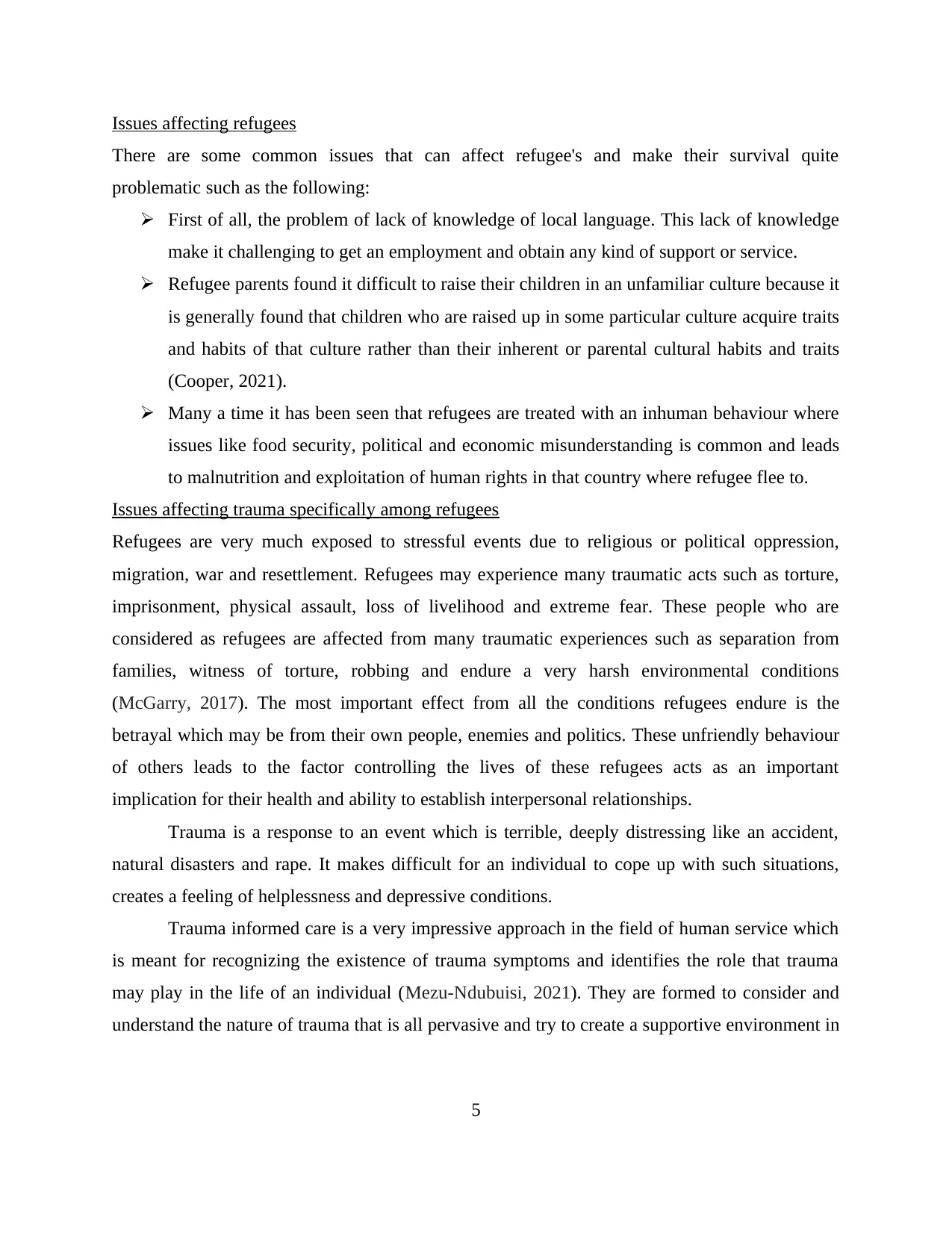
Issues affecting refugees
There are some common issues that can affect refugee's and make their survival quite
problematic such as the following:
First of all, the problem of lack of knowledge of local language. This lack of knowledge
make it challenging to get an employment and obtain any kind of support or service.
Refugee parents found it difficult to raise their children in an unfamiliar culture because it
is generally found that children who are raised up in some particular culture acquire traits
and habits of that culture rather than their inherent or parental cultural habits and traits
(Cooper, 2021).
Many a time it has been seen that refugees are treated with an inhuman behaviour where
issues like food security, political and economic misunderstanding is common and leads
to malnutrition and exploitation of human rights in that country where refugee flee to.
Issues affecting trauma specifically among refugees
Refugees are very much exposed to stressful events due to religious or political oppression,
migration, war and resettlement. Refugees may experience many traumatic acts such as torture,
imprisonment, physical assault, loss of livelihood and extreme fear. These people who are
considered as refugees are affected from many traumatic experiences such as separation from
families, witness of torture, robbing and endure a very harsh environmental conditions
(McGarry, 2017). The most important effect from all the conditions refugees endure is the
betrayal which may be from their own people, enemies and politics. These unfriendly behaviour
of others leads to the factor controlling the lives of these refugees acts as an important
implication for their health and ability to establish interpersonal relationships.
Trauma is a response to an event which is terrible, deeply distressing like an accident,
natural disasters and rape. It makes difficult for an individual to cope up with such situations,
creates a feeling of helplessness and depressive conditions.
Trauma informed care is a very impressive approach in the field of human service which
is meant for recognizing the existence of trauma symptoms and identifies the role that trauma
may play in the life of an individual (Mezu‐Ndubuisi, 2021). They are formed to consider and
understand the nature of trauma that is all pervasive and try to create a supportive environment in
5
There are some common issues that can affect refugee's and make their survival quite
problematic such as the following:
First of all, the problem of lack of knowledge of local language. This lack of knowledge
make it challenging to get an employment and obtain any kind of support or service.
Refugee parents found it difficult to raise their children in an unfamiliar culture because it
is generally found that children who are raised up in some particular culture acquire traits
and habits of that culture rather than their inherent or parental cultural habits and traits
(Cooper, 2021).
Many a time it has been seen that refugees are treated with an inhuman behaviour where
issues like food security, political and economic misunderstanding is common and leads
to malnutrition and exploitation of human rights in that country where refugee flee to.
Issues affecting trauma specifically among refugees
Refugees are very much exposed to stressful events due to religious or political oppression,
migration, war and resettlement. Refugees may experience many traumatic acts such as torture,
imprisonment, physical assault, loss of livelihood and extreme fear. These people who are
considered as refugees are affected from many traumatic experiences such as separation from
families, witness of torture, robbing and endure a very harsh environmental conditions
(McGarry, 2017). The most important effect from all the conditions refugees endure is the
betrayal which may be from their own people, enemies and politics. These unfriendly behaviour
of others leads to the factor controlling the lives of these refugees acts as an important
implication for their health and ability to establish interpersonal relationships.
Trauma is a response to an event which is terrible, deeply distressing like an accident,
natural disasters and rape. It makes difficult for an individual to cope up with such situations,
creates a feeling of helplessness and depressive conditions.
Trauma informed care is a very impressive approach in the field of human service which
is meant for recognizing the existence of trauma symptoms and identifies the role that trauma
may play in the life of an individual (Mezu‐Ndubuisi, 2021). They are formed to consider and
understand the nature of trauma that is all pervasive and try to create a supportive environment in
5
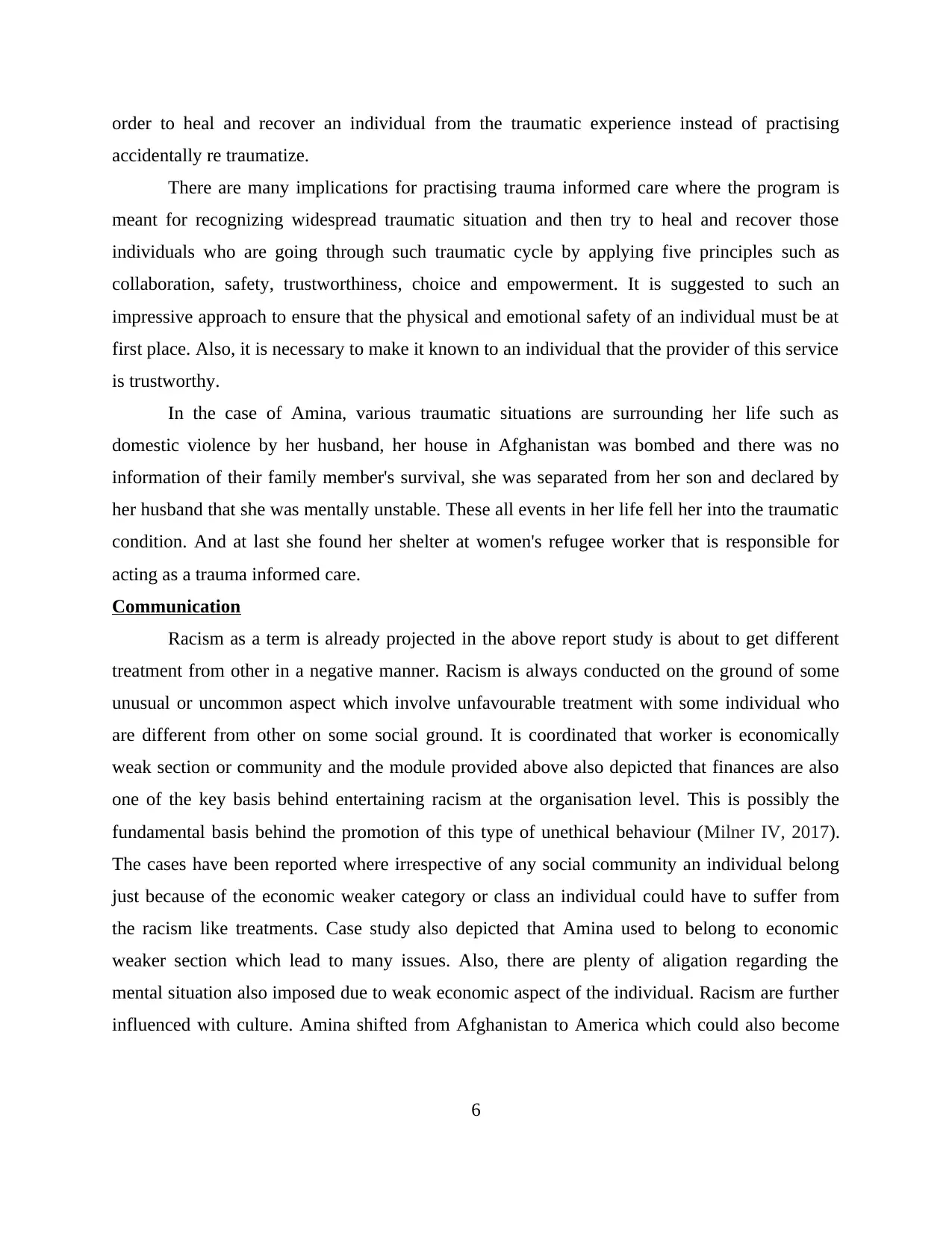
order to heal and recover an individual from the traumatic experience instead of practising
accidentally re traumatize.
There are many implications for practising trauma informed care where the program is
meant for recognizing widespread traumatic situation and then try to heal and recover those
individuals who are going through such traumatic cycle by applying five principles such as
collaboration, safety, trustworthiness, choice and empowerment. It is suggested to such an
impressive approach to ensure that the physical and emotional safety of an individual must be at
first place. Also, it is necessary to make it known to an individual that the provider of this service
is trustworthy.
In the case of Amina, various traumatic situations are surrounding her life such as
domestic violence by her husband, her house in Afghanistan was bombed and there was no
information of their family member's survival, she was separated from her son and declared by
her husband that she was mentally unstable. These all events in her life fell her into the traumatic
condition. And at last she found her shelter at women's refugee worker that is responsible for
acting as a trauma informed care.
Communication
Racism as a term is already projected in the above report study is about to get different
treatment from other in a negative manner. Racism is always conducted on the ground of some
unusual or uncommon aspect which involve unfavourable treatment with some individual who
are different from other on some social ground. It is coordinated that worker is economically
weak section or community and the module provided above also depicted that finances are also
one of the key basis behind entertaining racism at the organisation level. This is possibly the
fundamental basis behind the promotion of this type of unethical behaviour (Milner IV, 2017).
The cases have been reported where irrespective of any social community an individual belong
just because of the economic weaker category or class an individual could have to suffer from
the racism like treatments. Case study also depicted that Amina used to belong to economic
weaker section which lead to many issues. Also, there are plenty of aligation regarding the
mental situation also imposed due to weak economic aspect of the individual. Racism are further
influenced with culture. Amina shifted from Afghanistan to America which could also become
6
accidentally re traumatize.
There are many implications for practising trauma informed care where the program is
meant for recognizing widespread traumatic situation and then try to heal and recover those
individuals who are going through such traumatic cycle by applying five principles such as
collaboration, safety, trustworthiness, choice and empowerment. It is suggested to such an
impressive approach to ensure that the physical and emotional safety of an individual must be at
first place. Also, it is necessary to make it known to an individual that the provider of this service
is trustworthy.
In the case of Amina, various traumatic situations are surrounding her life such as
domestic violence by her husband, her house in Afghanistan was bombed and there was no
information of their family member's survival, she was separated from her son and declared by
her husband that she was mentally unstable. These all events in her life fell her into the traumatic
condition. And at last she found her shelter at women's refugee worker that is responsible for
acting as a trauma informed care.
Communication
Racism as a term is already projected in the above report study is about to get different
treatment from other in a negative manner. Racism is always conducted on the ground of some
unusual or uncommon aspect which involve unfavourable treatment with some individual who
are different from other on some social ground. It is coordinated that worker is economically
weak section or community and the module provided above also depicted that finances are also
one of the key basis behind entertaining racism at the organisation level. This is possibly the
fundamental basis behind the promotion of this type of unethical behaviour (Milner IV, 2017).
The cases have been reported where irrespective of any social community an individual belong
just because of the economic weaker category or class an individual could have to suffer from
the racism like treatments. Case study also depicted that Amina used to belong to economic
weaker section which lead to many issues. Also, there are plenty of aligation regarding the
mental situation also imposed due to weak economic aspect of the individual. Racism are further
influenced with culture. Amina shifted from Afghanistan to America which could also become
6
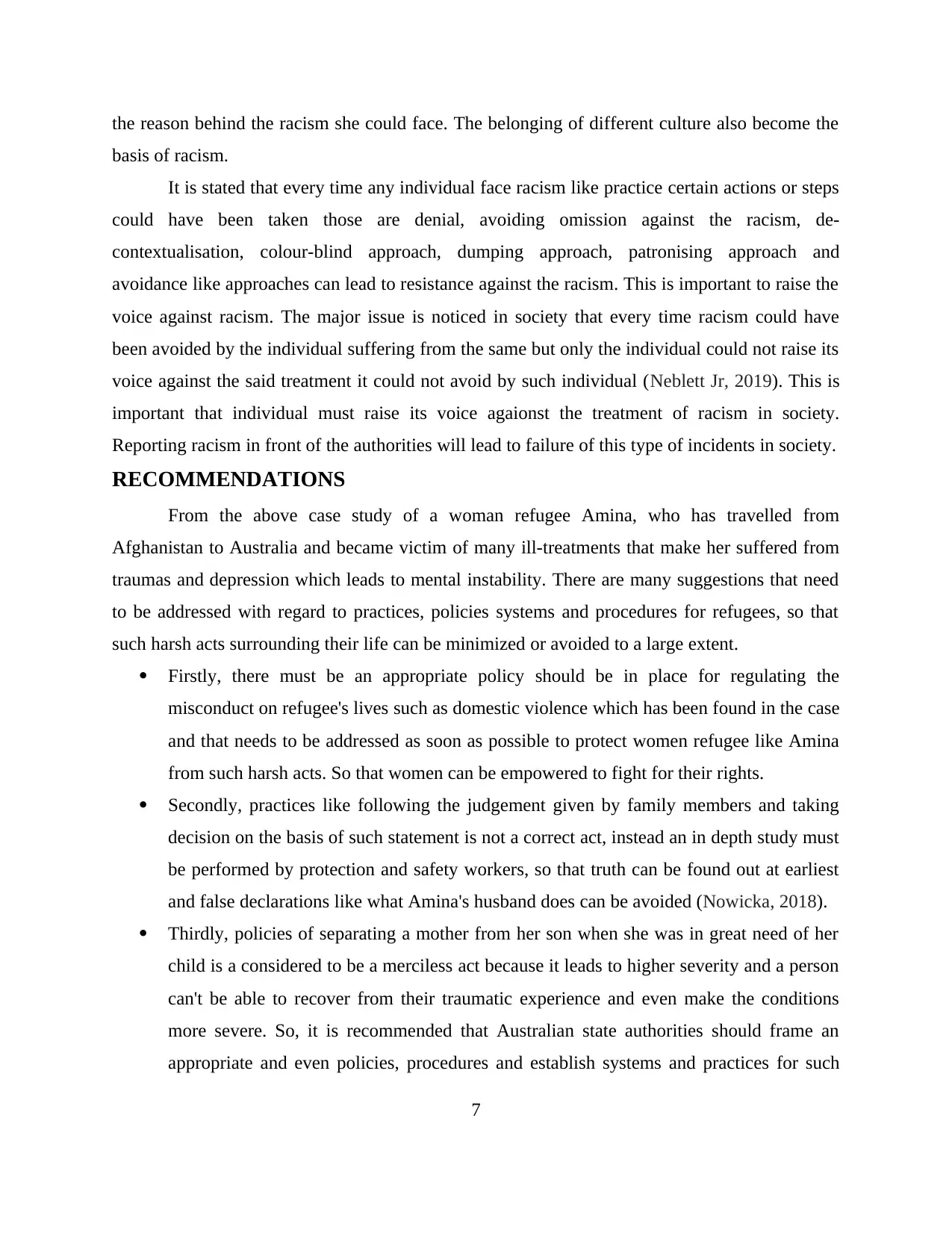
the reason behind the racism she could face. The belonging of different culture also become the
basis of racism.
It is stated that every time any individual face racism like practice certain actions or steps
could have been taken those are denial, avoiding omission against the racism, de-
contextualisation, colour-blind approach, dumping approach, patronising approach and
avoidance like approaches can lead to resistance against the racism. This is important to raise the
voice against racism. The major issue is noticed in society that every time racism could have
been avoided by the individual suffering from the same but only the individual could not raise its
voice against the said treatment it could not avoid by such individual (Neblett Jr, 2019). This is
important that individual must raise its voice agaionst the treatment of racism in society.
Reporting racism in front of the authorities will lead to failure of this type of incidents in society.
RECOMMENDATIONS
From the above case study of a woman refugee Amina, who has travelled from
Afghanistan to Australia and became victim of many ill-treatments that make her suffered from
traumas and depression which leads to mental instability. There are many suggestions that need
to be addressed with regard to practices, policies systems and procedures for refugees, so that
such harsh acts surrounding their life can be minimized or avoided to a large extent.
Firstly, there must be an appropriate policy should be in place for regulating the
misconduct on refugee's lives such as domestic violence which has been found in the case
and that needs to be addressed as soon as possible to protect women refugee like Amina
from such harsh acts. So that women can be empowered to fight for their rights.
Secondly, practices like following the judgement given by family members and taking
decision on the basis of such statement is not a correct act, instead an in depth study must
be performed by protection and safety workers, so that truth can be found out at earliest
and false declarations like what Amina's husband does can be avoided (Nowicka, 2018).
Thirdly, policies of separating a mother from her son when she was in great need of her
child is a considered to be a merciless act because it leads to higher severity and a person
can't be able to recover from their traumatic experience and even make the conditions
more severe. So, it is recommended that Australian state authorities should frame an
appropriate and even policies, procedures and establish systems and practices for such
7
basis of racism.
It is stated that every time any individual face racism like practice certain actions or steps
could have been taken those are denial, avoiding omission against the racism, de-
contextualisation, colour-blind approach, dumping approach, patronising approach and
avoidance like approaches can lead to resistance against the racism. This is important to raise the
voice against racism. The major issue is noticed in society that every time racism could have
been avoided by the individual suffering from the same but only the individual could not raise its
voice against the said treatment it could not avoid by such individual (Neblett Jr, 2019). This is
important that individual must raise its voice agaionst the treatment of racism in society.
Reporting racism in front of the authorities will lead to failure of this type of incidents in society.
RECOMMENDATIONS
From the above case study of a woman refugee Amina, who has travelled from
Afghanistan to Australia and became victim of many ill-treatments that make her suffered from
traumas and depression which leads to mental instability. There are many suggestions that need
to be addressed with regard to practices, policies systems and procedures for refugees, so that
such harsh acts surrounding their life can be minimized or avoided to a large extent.
Firstly, there must be an appropriate policy should be in place for regulating the
misconduct on refugee's lives such as domestic violence which has been found in the case
and that needs to be addressed as soon as possible to protect women refugee like Amina
from such harsh acts. So that women can be empowered to fight for their rights.
Secondly, practices like following the judgement given by family members and taking
decision on the basis of such statement is not a correct act, instead an in depth study must
be performed by protection and safety workers, so that truth can be found out at earliest
and false declarations like what Amina's husband does can be avoided (Nowicka, 2018).
Thirdly, policies of separating a mother from her son when she was in great need of her
child is a considered to be a merciless act because it leads to higher severity and a person
can't be able to recover from their traumatic experience and even make the conditions
more severe. So, it is recommended that Australian state authorities should frame an
appropriate and even policies, procedures and establish systems and practices for such
7
Paraphrase This Document
Need a fresh take? Get an instant paraphrase of this document with our AI Paraphraser
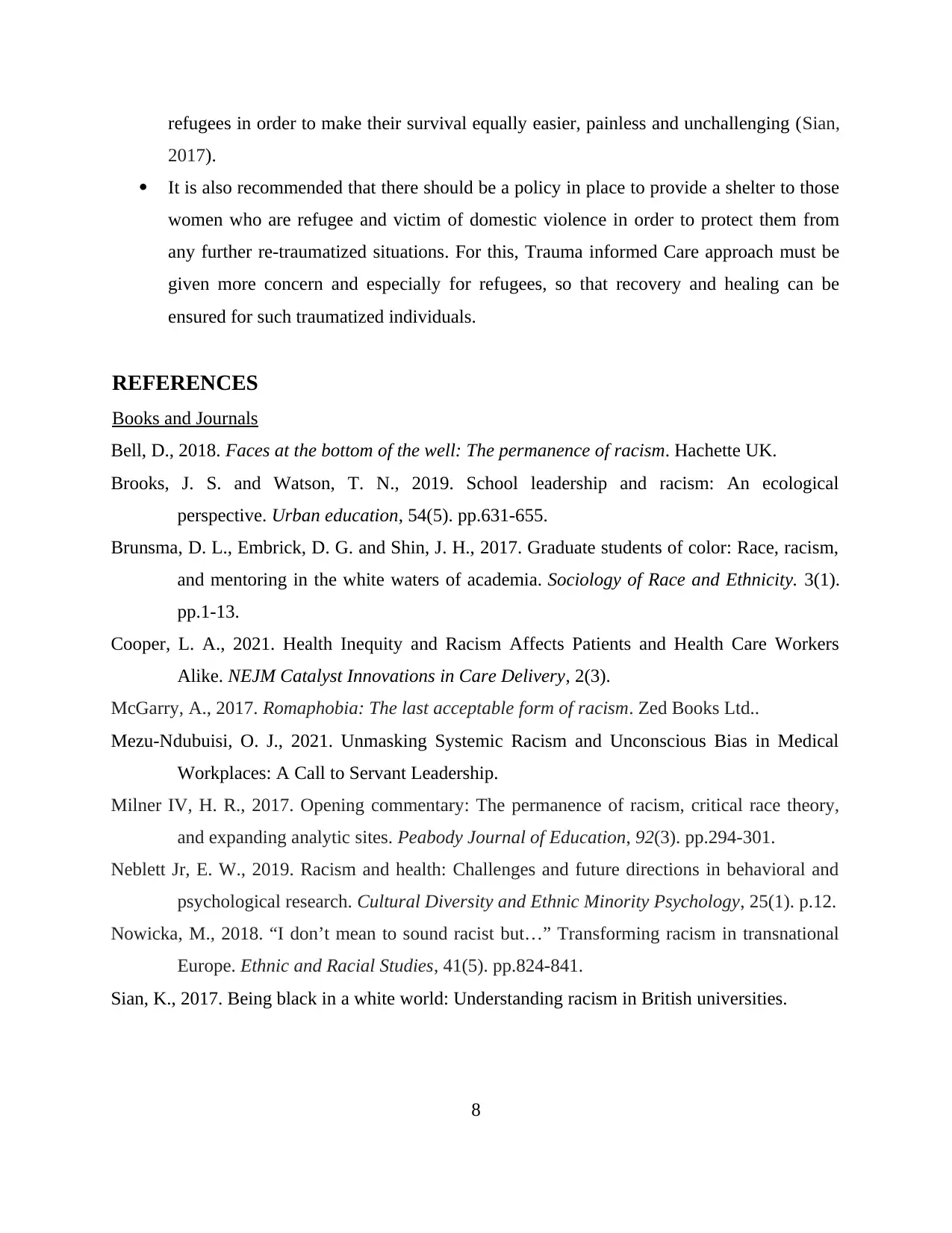
refugees in order to make their survival equally easier, painless and unchallenging (Sian,
2017).
It is also recommended that there should be a policy in place to provide a shelter to those
women who are refugee and victim of domestic violence in order to protect them from
any further re-traumatized situations. For this, Trauma informed Care approach must be
given more concern and especially for refugees, so that recovery and healing can be
ensured for such traumatized individuals.
REFERENCES
Books and Journals
Bell, D., 2018. Faces at the bottom of the well: The permanence of racism. Hachette UK.
Brooks, J. S. and Watson, T. N., 2019. School leadership and racism: An ecological
perspective. Urban education, 54(5). pp.631-655.
Brunsma, D. L., Embrick, D. G. and Shin, J. H., 2017. Graduate students of color: Race, racism,
and mentoring in the white waters of academia. Sociology of Race and Ethnicity. 3(1).
pp.1-13.
Cooper, L. A., 2021. Health Inequity and Racism Affects Patients and Health Care Workers
Alike. NEJM Catalyst Innovations in Care Delivery, 2(3).
McGarry, A., 2017. Romaphobia: The last acceptable form of racism. Zed Books Ltd..
Mezu‐Ndubuisi, O. J., 2021. Unmasking Systemic Racism and Unconscious Bias in Medical
Workplaces: A Call to Servant Leadership.
Milner IV, H. R., 2017. Opening commentary: The permanence of racism, critical race theory,
and expanding analytic sites. Peabody Journal of Education, 92(3). pp.294-301.
Neblett Jr, E. W., 2019. Racism and health: Challenges and future directions in behavioral and
psychological research. Cultural Diversity and Ethnic Minority Psychology, 25(1). p.12.
Nowicka, M., 2018. “I don’t mean to sound racist but…” Transforming racism in transnational
Europe. Ethnic and Racial Studies, 41(5). pp.824-841.
Sian, K., 2017. Being black in a white world: Understanding racism in British universities.
8
2017).
It is also recommended that there should be a policy in place to provide a shelter to those
women who are refugee and victim of domestic violence in order to protect them from
any further re-traumatized situations. For this, Trauma informed Care approach must be
given more concern and especially for refugees, so that recovery and healing can be
ensured for such traumatized individuals.
REFERENCES
Books and Journals
Bell, D., 2018. Faces at the bottom of the well: The permanence of racism. Hachette UK.
Brooks, J. S. and Watson, T. N., 2019. School leadership and racism: An ecological
perspective. Urban education, 54(5). pp.631-655.
Brunsma, D. L., Embrick, D. G. and Shin, J. H., 2017. Graduate students of color: Race, racism,
and mentoring in the white waters of academia. Sociology of Race and Ethnicity. 3(1).
pp.1-13.
Cooper, L. A., 2021. Health Inequity and Racism Affects Patients and Health Care Workers
Alike. NEJM Catalyst Innovations in Care Delivery, 2(3).
McGarry, A., 2017. Romaphobia: The last acceptable form of racism. Zed Books Ltd..
Mezu‐Ndubuisi, O. J., 2021. Unmasking Systemic Racism and Unconscious Bias in Medical
Workplaces: A Call to Servant Leadership.
Milner IV, H. R., 2017. Opening commentary: The permanence of racism, critical race theory,
and expanding analytic sites. Peabody Journal of Education, 92(3). pp.294-301.
Neblett Jr, E. W., 2019. Racism and health: Challenges and future directions in behavioral and
psychological research. Cultural Diversity and Ethnic Minority Psychology, 25(1). p.12.
Nowicka, M., 2018. “I don’t mean to sound racist but…” Transforming racism in transnational
Europe. Ethnic and Racial Studies, 41(5). pp.824-841.
Sian, K., 2017. Being black in a white world: Understanding racism in British universities.
8
1 out of 8
Your All-in-One AI-Powered Toolkit for Academic Success.
+13062052269
info@desklib.com
Available 24*7 on WhatsApp / Email
![[object Object]](/_next/static/media/star-bottom.7253800d.svg)
Unlock your academic potential
© 2024 | Zucol Services PVT LTD | All rights reserved.





